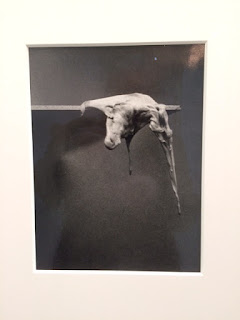Alina Szapocznikow
Coming to the Hepworth in Wakefield
is an Alina Szapocznikow exhibition; 'Human Landscapes', it is open from the 21st October
2017 to the 28th January 2018
Although mainly thought of as a
sculptor Szapocznikow was an artist that thought very much through drawing, the
book Alina Szapocznikow: From Drawing into Sculpture with a text by Annette
Messager, is a wonderful introduction to her work and thinking process.
She
was one of the first artists to use modern materials such as polyurethane foam
and polyester resin, and she reflects this wide ranging use of materials in her
drawings, using felt-tip, ballpoint, crayons, ink, watercolor and monoprinting
to visualise her ideas. Focusing on the
body as a site for humor, sexuality and exuberance, Szapocznikow can be seen as someone who worked across several
boundaries, aware of Surrealism, Pop Art and other Modernist movements she was though I believe in reality part of a much older tradition, one that artists such as Klara Kristalova belong to.
Klara Kristalova
There is a North Eastern European tradition that
includes the tales of the Baba Yaga and other stories from
Slavic folklore. These folk images although not referred to directly by artists such as Szapocznikow or Kristalova, have an
image bank associated with them that runs deeply through the unconscious of
many artists. From Mark Chagall to Russian lubok prints, there is a particular
Slavic imagination that I have always responded to, one that I now realise, I am inextricably linked to.
Lubok print of Baba Yaga
Mark Chagall
This interest of mine may be
because my grandmother was of Polish Jewish heritage, or it may simply be that
these are good working Jungian archetypes, it doesn’t really matter, but what I
will be doing is going to see Szapocznikow’s exhibition and would
recommend her work to any of you interested in how drawing can be used as a way
to help visualise ideas in sculpture.
Alina Szapocznikow
I'm returning to this post after actually visiting the exhibition. The work itself is stunning and for those of you interested in drawing there is much to think about. One aspect of her work is the formal invention she takes it through and the move from being a very traditional stone carver to working in new plastic materials is clearly illustrated. Her early drawings demonstrate this formal invention and are interesting as a way of exploring how someone thinking about form in sculpture can save time by drawing. However it was her late drawings that I found the most powerful. They are very simple, and yet in their very simplicity I found great affect.
The four drawings above are small, about A4 size, made with a red marker. You can see the old creases in the paper from when these drawings were dropped to the floor or simply left somewhere as she moved on. They are not drawings made for display, they are thinking drawings and Szapocznikow is thinking about how cancer has begun to spread in her body. The masses of cells are part of her body and are also taking over the body. They have already invaded her breasts and are now dropping down into her womb. They live in her, like some child of death. I mentioned in my first draft of this post that I suspected that Szapocznikow's Slavic heritage may also be an influence on her work, I'm not sure any more about this, but the fact that when peasants made dolls of the Goddess of Winter, Morana, these were often ritually destroyed, seemed to me to fit perfectly with the broken, destroyed bodies that were found at the core of this exhibition.
Alina Szapocznikow: Chewing gum sculpture
The making of things formed in the mouth is somehow elemental. There is a section devoted to Szapocznikow's chewing gum sculptures. The bringing of these small chewed mouth casts into the open and having them photographed so beautifully, is a life affirming act, one that shows how much Szapocznikow was aware of the body's life as a sculptural process in its own right.
From the malleability of the flesh to the sculptural impermanence of bone, Szapocznikow's work is a deep meditation on mortality and as such I would really urge you to visit the exhibition while it is here in West Yorkshire.


















Amazing...
ReplyDeleteHow to pass Nebosh IGC3
Nebosh IGC Registration
IOSH MS course in Chennai
Nebosh Course in Chennai
Safety Courses in India